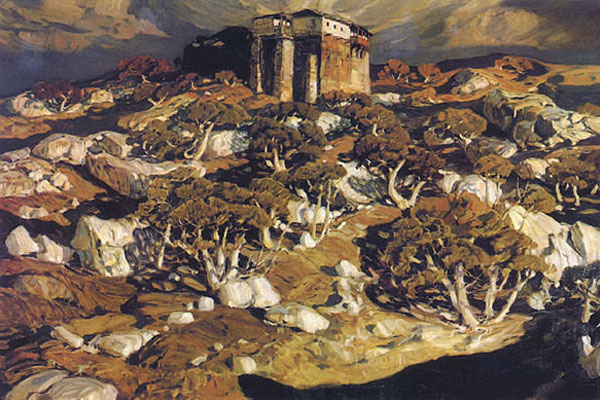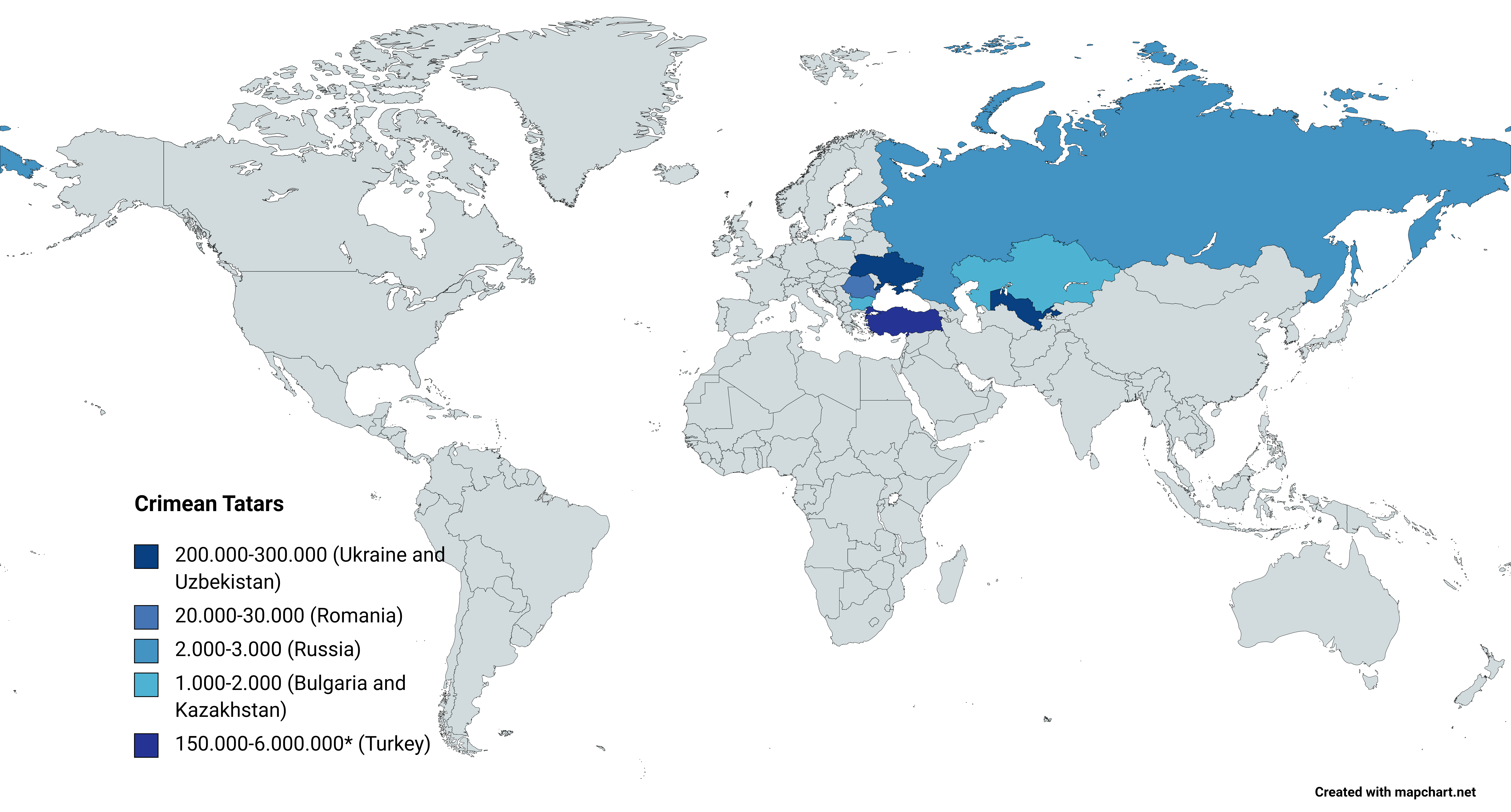|
Crimean Khanate
The Crimean Khanate ( crh, , or ), officially the Great Horde and Desht-i Kipchak () and in old European historiography and geography known as Little Tartary ( la, Tartaria Minor), was a Crimean Tatar state existing from 1441 to 1783, the longest-lived of the Turkic khanates that succeeded the empire of the Golden Horde. Established by Hacı I Giray in 1441, it was regarded as the direct heir to the Golden Horde and to Desht-i-Kipchak. In 1783, violating the 1774 Treaty of Küçük Kaynarca (which had guaranteed non-interference of both Russia and the Ottoman Empire in the affairs of the Crimean Khanate), the Russian Empire annexed the khanate. Among the European powers, only France came out with an open protest against this act, due to the longstanding Franco-Ottoman alliance. Naming and geography Crimean khans, considering their state as the heir and legal successor of the Golden Horde and Desht-i Kipchak, called themselves khans of "the Great Horde, the Great State and th ... [...More Info...] [...Related Items...] OR: [Wikipedia] [Google] [Baidu] |
Khanate
A khaganate or khanate was a polity ruled by a khan, khagan, khatun, or khanum. That political territory was typically found on the Eurasian Steppe and could be equivalent in status to tribal chiefdom, principality, kingdom or empire. Mongol-ruled khanates Chagatai Khanate (1226–1347) After Genghis Khan established appanages for his family in the Mongol Empire during his rule (1206–1227), his sons, daughters, and grandsons inherited separate sections of the empire. The Mongol Empire and Mongolian khanates that emerged from those appanages are listed below. In 1226, the second son of Genghis Khan, Chagatai Khan established the Chagatai Khanate. At its height in the late 13th century, the khanate extended from the Amu Darya south of the Aral Sea to the Altai Mountains in the border of modern-day Mongolia and China, roughly corresponding to the defunct Qara Khitai Empire. Initially the rulers of the Chagatai Khanate recognized the supremacy of the Great Khan, but b ... [...More Info...] [...Related Items...] OR: [Wikipedia] [Google] [Baidu] |
Stary Krym
Staryi Krym (russian: Старый Крым; uk, Старий Крим; crh, Eski Qırım, italic=yes; in all three languages) is a small historical town and former bishopric in Kirovske Raion of Crimea, Ukraine. It has been illegally occupied by Russia since 2014 (see Annexation of Crimea by the Russian Federation). It is located in the Eastern Crimean Peninsula, approximately 25 km (15 mi.) west of Theodosia. Population: Names During the late 13th century, the town was known as either ''Solkhat'' (''Solkhad'', ''Solghad'', ) or as ''Qrım'' ( ). Neither name is attested prior to the 13th century, but on the authority of al-Qalqashandi, ''Solkhat'' is the older of the two, dating to the period prior to the Mongol conquest in mid-1238. Both names coexisted during the 14th century, but the name ''Qırım'' came to displace ''Solkhat'' by the early 15th. The origin of either name is uncertain. Some consider ''Solkhat'' to be related to the Greek ''Colchis''. ... [...More Info...] [...Related Items...] OR: [Wikipedia] [Google] [Baidu] |
Golden Horde
The Golden Horde, self-designated as Ulug Ulus, 'Great State' in Turkic, was originally a Mongols, Mongol and later Turkicized khanate established in the 13th century and originating as the northwestern sector of the Mongol Empire. With the fragmentation of the Mongol Empire after 1259 it became a functionally separate khanate. It is also known as the Kipchak Khanate or as the Ulus of Jochi, and replaced the earlier less organized Cuman–Kipchak confederation. After the death of Batu Khan (the founder of the Golden Horde) in 1255, his dynasty flourished for a full century, until 1359, though the intrigues of Nogai Khan, Nogai instigated a partial civil war in the late 1290s. The Horde's military power peaked during the reign of Uzbeg Khan (1312–1341), who adopted Islam. The territory of the Golden Horde at its peak extended from Siberia and Central Asia to parts of Eastern Europe from the Ural Mountains, Urals to the Danube in the west, and from the Black Sea to the Caspian ... [...More Info...] [...Related Items...] OR: [Wikipedia] [Google] [Baidu] |
Crimean Tatars
, flag = Flag of the Crimean Tatar people.svg , flag_caption = Flag of Crimean Tatars , image = Love, Peace, Traditions.jpg , caption = Crimean Tatars in traditional clothing in front of the Khan's Palace , poptime = , popplace = , region1 = , pop1 = 3,500,000 6,000,000 , ref1 = , region2 = * , pop2 = 248,193 , ref2 = , region3 = , pop3 = 239,000 , ref3 = , region4 = , pop4 = 24,137 , ref4 = , region5 = , pop5 = 2,449 , ref5 = , region7 = , pop7 = 1,803 , ref7 = , region8 = , pop8 = 1,532 , ref8 = , region9 = *() , pop9 = 7,000(500–1,000) , ref9 = , region10 = Total , pop10 = 4.024.114 (or 6.524.11 ... [...More Info...] [...Related Items...] OR: [Wikipedia] [Google] [Baidu] |
Akçe
The ''akçe'' or ''akça'' (also spelled ''akche'', ''akcheh''; ota, آقچه; ) refers to a silver coin which was the chief monetary unit of the Ottoman Empire. The word itself evolved from the word "silver or silver money", this word is derived from the Turkish ''ak'' ("white") and the diminutive suffix -''ça''. Three ''akçe''s were equal to one ''para''. One-hundred and twenty ''akçe''s equalled one ''kuruş''. Later after 1687 the ''kuruş'' became the main unit of account, replacing the ''akçe''. In 1843, the silver ''kuruş'' was joined by the gold lira in a bimetallic system. Its weight fluctuated, one source estimates it is between 1.15 and 1.18 grams. The name ''akçe'' originally referred to a silver coin but later the meaning changed and it became a synonym for money. The mint in Novo Brdo, a fortified mining town in the Serbian Despotate rich with gold and silver mines, began to strike ''akçe'' in 1441 when it was captured by the Ottoman forces for the first ... [...More Info...] [...Related Items...] OR: [Wikipedia] [Google] [Baidu] |
Ukraine
Ukraine ( uk, Україна, Ukraïna, ) is a country in Eastern Europe. It is the second-largest European country after Russia, which it borders to the east and northeast. Ukraine covers approximately . Prior to the ongoing Russian invasion, it was the eighth-most populous country in Europe, with a population of around 41 million people. It is also bordered by Belarus to the north; by Poland, Slovakia, and Hungary to the west; and by Romania and Moldova to the southwest; with a coastline along the Black Sea and the Sea of Azov to the south and southeast. Kyiv is the nation's capital and largest city. Ukraine's state language is Ukrainian; Russian is also widely spoken, especially in the east and south. During the Middle Ages, Ukraine was the site of early Slavic expansion and the area later became a key centre of East Slavic culture under the state of Kievan Rus', which emerged in the 9th century. The state eventually disintegrated into rival regional po ... [...More Info...] [...Related Items...] OR: [Wikipedia] [Google] [Baidu] |
Russia
Russia (, , ), or the Russian Federation, is a List of transcontinental countries, transcontinental country spanning Eastern Europe and North Asia, Northern Asia. It is the List of countries and dependencies by area, largest country in the world, with its internationally recognised territory covering , and encompassing one-eighth of Earth's inhabitable landmass. Russia extends across Time in Russia, eleven time zones and shares Borders of Russia, land boundaries with fourteen countries, more than List of countries and territories by land borders, any other country but China. It is the List of countries and dependencies by population, world's ninth-most populous country and List of European countries by population, Europe's most populous country, with a population of 146 million people. The country's capital and List of cities and towns in Russia by population, largest city is Moscow, the List of European cities by population within city limits, largest city entirely within E ... [...More Info...] [...Related Items...] OR: [Wikipedia] [Google] [Baidu] |
Moldova
Moldova ( , ; ), officially the Republic of Moldova ( ro, Republica Moldova), is a Landlocked country, landlocked country in Eastern Europe. It is bordered by Romania to the west and Ukraine to the north, east, and south. The List of states with limited recognition, unrecognised state of Transnistria lies across the Dniester river on the country's eastern border with Ukraine. Moldova's Capital city, capital and largest city is Chișinău. Most of Moldovan territory was a part of the Principality of Moldavia from the 14th century until 1812, when it was Treaty of Bucharest (1812), ceded to the Russian Empire by the Ottoman Empire (to which Moldavia was a Vassal state of the Ottoman Empire, vassal state) and became known as Bessarabia. In 1856, southern Bessarabia was returned to Moldavia, which three years later united with Wallachia to form United Principalities, Romania, but Russian rule was restored over the whole of the region in 1878. During the 1917 Russian Revolution, B ... [...More Info...] [...Related Items...] OR: [Wikipedia] [Google] [Baidu] |
Chagatai Language
Chagatai (چغتای, ''Čaġatāy''), also known as ''Turki'', Eastern Turkic, or Chagatai Turkic (''Čaġatāy türkīsi''), is an extinct Turkic literary language that was once widely spoken across Central Asia and remained the shared literary language there until the early 20th century. It was used across a wide geographic area including parts of modern-day Uzbekistan, Xinjiang, Kazakhstan, and Kyrgyzstan. Literary Chagatai is the predecessor of the modern Karluk branch of Turkic languages, which include Uzbek and Uyghur. Turkmen, which is not within the Karluk branch but in the Oghuz branch of Turkic languages, had been heavily influenced by Chagatai for centuries. Ali-Shir Nava'i was the greatest representative of Chagatai literature. Chagatai literature is still studied in modern Uzbekistan, where the language is seen as the predecessor and the direct ancestor of modern Uzbek and the literature is regarded as part of the national heritage of Uzbekistan. Etymol ... [...More Info...] [...Related Items...] OR: [Wikipedia] [Google] [Baidu] |
Ottoman Turkish Language
Ottoman Turkish ( ota, لِسانِ عُثمانى, Lisân-ı Osmânî, ; tr, Osmanlı Türkçesi) was the standardized register of the Turkish language used by the citizens of the Ottoman Empire (14th to 20th centuries CE). It borrowed extensively, in all aspects, from Arabic and Persian, and its speakers used the Ottoman Turkish alphabet for written communication. During the peak of Ottoman power (), words of foreign origin in Turkish literature in the Ottoman Empire heavily outnumbered native Turkish words, with Arabic and Persian vocabulary accounting for up to 88% of the Ottoman vocabulary in some texts.''Persian Historiography & Geography''Pustaka Nasional Pte Ltd p 69 Consequently, Ottoman Turkish was largely unintelligible to the less-educated lower-class and to rural Turks, who continued to use ("raw/vulgar Turkish"; compare Vulgar Latin and Demotic Greek), which used far fewer foreign loanwords and is the basis of the modern standard. The Tanzimât era (1839–187 ... [...More Info...] [...Related Items...] OR: [Wikipedia] [Google] [Baidu] |
Nogai Language
Nogai (; ''Ногай тили, Nogay tili, Ногайша, Nogayşa'') also known as Noğay, Noghay, Nogay, or Nogai Tatar, is a Turkic language spoken in Southeastern European Russia, Kazakhstan, Uzbekistan, Ukraine, Bulgaria, Romania and in Turkey. It is the ancestral language of the Nogais. As a member of the Kipchak branch, it is closely related to Kazakh, Karakalpak and Crimean Tatar ( northern dialect). In 2014 the first Nogai novel (''Akşa Nenem'') was published, written in the Latin alphabet. Classification Nogai is generally classified into the Kipchak–Nogai branch of Kipchak Turkic. The latter also includes Siberian Tatar in Russia, Kazakh in Kazakhstan and Karakalpak in Uzbekistan. Three distinct dialects are recognized: * Karanogay or Qara-Nogai (literally "Black Nogai"; "Northern Nogai"), spoken in Dagestan and Chechnya. * Central Nogai or Nogai Proper, in Stavropol. * Aqnogai (White or Western Nogai), by the Kuban River, its tributaries in Karachay� ... [...More Info...] [...Related Items...] OR: [Wikipedia] [Google] [Baidu] |
Crimean Tatar Language
Crimean Tatar () also called Crimean (), is a Kipchak Turkic language spoken in Crimea and the Crimean Tatar diasporas of Uzbekistan, Turkey, Romania, and Bulgaria, as well as small communities in the United States and Canada. It should not be confused with Tatar proper, spoken in Tatarstan and adjacent regions in Russia; the languages are related, but belong to two different subgroups of the Kipchak languages and thus are not mutually intelligible. It has been extensively influenced by nearby Oghuz dialects. A long-term ban on the study of the Crimean Tatar language following the deportation of the Crimean Tatars by the Soviet government has led to the fact that at the moment UNESCO ranked the Crimean Tatar language among the languages under serious threat of extinction (''severely endangered''). Number of speakers Today, more than 260,000 Crimean Tatars live in Crimea. Approximately 150,000 reside in Central Asia (mainly in Uzbekistan), where their ancestors had been ... [...More Info...] [...Related Items...] OR: [Wikipedia] [Google] [Baidu] |



